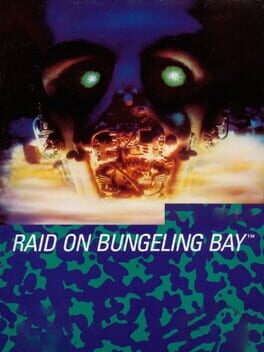Raid on Bungeling Bay has the player controlling a helicopter which is on a mission to destroy everything that moves. The only ally is the carrier, which is where the player begins at each level and may return to for repair and pick up bombs, as long as the player manages to protect it from being destroyed. The main goal in each level is to destroy a factory, which requires a steady increasing amount of bombs. Enemy forces include ships, planes, tanks, anti-air guns, and eventually, a large battleship.
Reviews View More
Published by Brøderbund, Raid on Bungeling Bay takes the general narrative frame of its other games and proposes a variation of the traditional shoot'em up. This exercise is probably understandable insofar as Will Wright is at the helm: the title is more strategic and less focused on nervous action. Nevertheless, it is above all a prototype, a project started on a whim to test the capacities of the Commodore 64, after the domination of the Apple II. From a formal point of view, the game seems greatly inspired by the wargames that have structured Wright's creative vision throughout his career.
The title places the player in a helicopter, which starts on an aircraft carrier. The aim of a game is to destroy six factories, protected by a defensive system: tanks and ground-to-air guns are supported by radars, cruisers and fighter planes. Destroying a factory requires an increasing number of bombs, which are recovered by returning to the aircraft carrier – it also serves as a repair facility. The carrier can be attacked by the opposing army, forcing the player to sometimes retreat and enter a defensive sequence. Such an approach is interesting and seeks to create strategic tension, but it fails in several respects. In particular, the lack of feedback makes it difficult to realise the importance of ammunition and it would have been more interesting to position additional bombs in key locations defended by enemies. On the other hand, the defensive gameplay fails, because visibility remains relatively poor, which gives the impression of having to travel a significant distance to return to defend the base; the frustration is even greater in the NES port, since it does not have the mini-map present on the Commodore 64 version. Beyond these elements, the title remains quite difficult: the player is quickly in a disadvantageous position, as soon as the fighter planes arrive, especially because our helicopter can only fire one projectile at a time.
Will Wright himself identified these problems, which is underlined by his presentation at the GDC 2011. Perhaps the game's greatest achievement is the editor Wright has programmed to create the various islands. These are diverse and have an organic structure that is pleasing to the eye. It is precisely because there is a real attention to detail in the topography of the islands that the aforementioned problems are frustrating. Overall, it is easy to see the potential of this tool and to understand why Wright afterwards shifted his attention on simulation games with SimCity (1989; development started in 1985). As early as Raid on Bungeling Bay, he was demonstrating a true constructivist and structuralist spirit. The game is a surprising historical curiosity, but is probably more interesting to watch and discuss than to play.
The title places the player in a helicopter, which starts on an aircraft carrier. The aim of a game is to destroy six factories, protected by a defensive system: tanks and ground-to-air guns are supported by radars, cruisers and fighter planes. Destroying a factory requires an increasing number of bombs, which are recovered by returning to the aircraft carrier – it also serves as a repair facility. The carrier can be attacked by the opposing army, forcing the player to sometimes retreat and enter a defensive sequence. Such an approach is interesting and seeks to create strategic tension, but it fails in several respects. In particular, the lack of feedback makes it difficult to realise the importance of ammunition and it would have been more interesting to position additional bombs in key locations defended by enemies. On the other hand, the defensive gameplay fails, because visibility remains relatively poor, which gives the impression of having to travel a significant distance to return to defend the base; the frustration is even greater in the NES port, since it does not have the mini-map present on the Commodore 64 version. Beyond these elements, the title remains quite difficult: the player is quickly in a disadvantageous position, as soon as the fighter planes arrive, especially because our helicopter can only fire one projectile at a time.
Will Wright himself identified these problems, which is underlined by his presentation at the GDC 2011. Perhaps the game's greatest achievement is the editor Wright has programmed to create the various islands. These are diverse and have an organic structure that is pleasing to the eye. It is precisely because there is a real attention to detail in the topography of the islands that the aforementioned problems are frustrating. Overall, it is easy to see the potential of this tool and to understand why Wright afterwards shifted his attention on simulation games with SimCity (1989; development started in 1985). As early as Raid on Bungeling Bay, he was demonstrating a true constructivist and structuralist spirit. The game is a surprising historical curiosity, but is probably more interesting to watch and discuss than to play.
